Dudley and Stourbridge Tramways, later Dudley, Stourbridge and District Electric Tramways
(including the Kinver Light Railway)
History
The Dudley and Stourbridge Tramways began life in 1880 under the auspices of the Dudley, Stourbridge and Kingswinford Tramways Company, which was registered on the 22nd December that year. Although the company aimed to build tramways between all the places in its title, it failed to gain approval for its Kingswinford line — within the Dudley, Stourbridge and Kingswinford Tramway Order, 1881 — so changed its name the following year to the more apposite Dudley and Stourbridge Steam Tramways Company Limited.
Construction of the 3ft 6ins-gauge tramway probably started in 1883, the line opening throughout on the 31st May 1884. The motive power was provided by eight steam tram engines manufactured by Kitson and Sons of Leeds, which were eventually joined by four more of their compatriots (one in 1885; one in late 1891/early 1892; and two in 1895/1896).
In 1886, the company obtained powers for a further 2.6 miles of tramway — under the Dudley and Kingswinford Tramways Act, 1885 — though all that was ever built was a short extension to the line in Stourbridge, which opened on the 30th July 1887. This took the tramway to its final size of 5.15 miles, the route being notable for its severe gradients, which up until that time had not been tackled by a steam tramway. From Dudley, where the terminus was situated at the junctions of Tipton and Birmingham Roads, the line ran southwestwards via Hart's Hill and Brierley Hill to the junction of Brettell Lane and Audnam High Street, whereupon it turned southwards through Amblecote to a terminus in Stourbridge High Street, just beyond the latter's junction with Mill Street. In Dudley, the lines of the D&SSTCo met those of Birmingham & Midland Tramways Limited, as well as the South Staffordshire and Birmingham District Steam Tramways Company (later South Staffordshire Tramways Company), and was connected to them, all being of the same gauge. Although each company had rights to operate over short lengths of the others' track (to facilitate waiting and turning), through services were not operated. Although the southern terminus of the Dudley, Sedgley and Wolverhampton Tramways Company was also situated in Dudley, it was in Wolverhampton Street, some distance short of the D&SSTCo's tracks, and built to standard gauge rather than the 3ft 6ins gauge of the D&SSTCo.
The D&SDTCo was mostly operated at a profit, though its dividends sank from a high of 6% in 1885 to 1.5% in 1894, largely as a result of trade depressions, to which it was especially susceptible. The company appears to have been in no position to finance electrification, though it did relay most of the track (not always well), and even purchased two new steam engines as late as the mid-1890s. In 1897, the British Electric Traction Company, which was developing ambitious plans for a large electric tramway system centred on the Black Country and Birmingham, began negotiations, both to purchase the company, and with the local authorities, as it was essential to the BETCo's plans that the authorities' right to buy the tramways within their municipal areas be deferred. The majority of D&SSTCo shares were duly acquired in 1897, and the purchase was formally completed on the 2nd April 1898, the company's name then being changed to the Dudley, Stourbridge and District Electric Traction Company limited.
Meanwhile, the BETCo applied for powers to convert the steam tramway to electric traction, and to build new lines; these were, however, opposed by Dudley Corporation, which in turn for dropping its objections, succeeded in forcing the BETCo to agree to sell it the tramways within its boundaries (four years from the 11th August 1898), which it would then lease back to the BETCo. The resulting Dudley and District Light Railways Order, which was granted on the 5th November 1898, authorised the construction of new lines to Cradley Heath and to Kingswinford (essentially a loop via Pensnett and via Wordsley), with powers for further lines, from Stourbridge to Lye, and from Stourbridge to Wollaston, being obtained on the 3rd April 1900.
At the same time that the Dudley and District Light Railways Order was proposed, agents of the BETCo also promoted a tramway between Amblecote — where it would be connected to the DS&DETCo line — and Kinver, powers for this being granted on the 7th March 1899, under the Kinver Light Railway Order, 1898.
The DS&DETCo main line (from Dudley to Stourbridge High Street) opened on the 26th July 1899, the last steam tram running the day before. The rest of the system opened as follows: Dudley to Cradley Heath (1st October 1900); Kingswinford (6th December 1900); Stourbridge to Lye (1st November 1902); and Stourbridge to Wollaston (13th December 1902).
The DS&DETC also operated services between Dudley and Sedgley from the 3rd October 1900 through to early 1902, initially for the BETCo, but from 1st February 1901 for Wolverhampton District Electric Tramways Limited, to which the BETCo had transferred the line and its powers. The BETCo also agreed (in April 1900), to sell its D&DLR powers (and the completed tramways) to the DS&DETCo; in addition, it also agreed to lease operation of the KLR to the DS&DETCo for a period of two years from its opening. The KLR duly opened on the 5th April 1901, and though initially operated under the aforementioned lease, this came to an end on the 29th September 1902, when the DS&DETCo formally purchased the tramway from its parent company.
On the 4th December 1903, it was agreed that all the BETCo's Black Country and Birmingham-area tramway interests would be merged into Birmingham & Midland Tramways Limited. From the 1st July 1904, all these systems (operated by Birmingham and Midland Tramways Limited; the City of Birmingham Tramways Company; the Dudley, Stourbridge and District Electric Traction Company; the South Staffordshire Tramways [Lessee] Company; and Wolverhampton District Electric Tramways Limited) were managed as a single entity by the Birmingham and Midland Tramways Joint Committee (B&MTJC). The merger resulted in economies of scale across the enterprise, perhaps most notably in the introduction of a very successful Tramways Parcels Express Service (begun in 1905), and the setting up of a major tramcar building and maintenance facility at Tividale, between Dudley and Oldbury.
The last new line to be worked by the DS&DETCo was opened on the 19th November 1904, from Old Hill (near Cradley Heath) to Blackheath. This was owned by the local authority (Rowley Regis Urban District Council), with operation leased to the DS&DETCo (via Birmingham and Midland Tramways Limited) for a period of 30 years. Over in Dudley, where the corporation had being attempting to buy the lines within its boundary (as it was legally entitled to do), agreement could not be reached; as a result, the two parties finally resorted to arbitration. This set a legally binding price, following which operation of the former tramways within Dudley was leased to the various BETCo subsidiaries for a period of 30 years (from the 1st January 1909).
This took the lines operated by the DS&DETCo to their maximum extent of 21.14 miles, a figure that includes the Kinver Light Railway (4.36 miles), but not lines that it later operated (briefly) as its sister companies abandoned tramway operation during the 1920s. The DS&DETCo's main line from Dudley ran southeastwards through Brierley Hill to Audnam High Street, then southwards through Amblecote to Stourbridge. From Stourbridge, lines ran eastwards through Lye to the Hayes, and westwards to Wollaston; a line also branched off the main line at Scott's Green in Dudley, which ran westwards through Pensnett to Kingswinford, then southwards through Wordsley to rejoin the main line at the junction of Audnam High Street and Brettell Lane. A further line also ran southeastwards from Dudley to Old Hill, where it divided, one line running southwestwards to Cradley Heath, the other eastwards to Blackheath. In Dudley, the DS&DETCo lines were connected to those of the WDETLtd (to Wolverhampton via Sedgley), the SSTCo (to Wednesbury via Tipton), and the B&MT (to Birmingham via Oldbury and Smethwick, and to West Bromwich via Bromford Lane and Spon Lane). Although these companies all ran services to Dudley, through traffic beyond Dudley was largely confined to specials and excursions to Stourbridge and Kinver.
The KLR connected to the DS&DET at Coalbournbrook in Amblecote, from where it ran southeastwards to Wollaston (where it again connected to the DS&DET), then westwards to Stourton, then roughly southwestwards to Kinver.
The B&MTL was also heavily involved in electricity generation, as well as motorbus operation, the company having set up a new enterprise — Birmingham and Midland Motor Omnibus Company Limited, which became known as 'Midland Red' — to manage all the constituent companies' motorbus interests on the 1st July 1905. On the 13th August 1912, B&MTL changed its name to Birmingham District Power and Traction Company Limited, presumably to better reflect its interests, particularly its expansion into electricity generation and supply. The management committee (the B&MTJC) was restructured in August 1915, when it expanded to include additional BETCo interests (not owned by the BDP&TCo), amongst them the Kidderminster and District Electric Light and Traction Company, owners of Kidderminster and Stourport Electric Tramways. As a result, the name of the committee was changed to the Birmingham and Midland Joint Committee of Electricity, Tramways and Motor Omnibus Undertakings, though the less unwieldy original name (B&MTJC) continued in general use.
The Great War brought much disruption to the DS&DET, including heavy loadings and greatly reduced maintenance, the latter due to loss of skilled workers (to the armed forces) and severe restrictions on spares and new materials. The tramway remained profitable, and despite rising costs and a post-war trade recession, the company pressed ahead with major track renewal, including the entire Dudley to Stourbridge main line (between 1919 and 1925), and new tramcars and major rebuilds.
In 1921, the DS&DETCo's parent company, the BDP&TCo, attempted to deal with the looming threat of lease expirations, many of its tramways being leased from local authorities. Although it submitted a parliamentary bill, and entered into lengthy dialogue with the local authorities in an attempt to push the various expirations out to a single date of the 31st December 1938, several of the larger authorities, particularly West Bromwich and Wolverhampton, were committed to municipal operation, and would not agree to extension of their leases. As a consequence, the resulting bill — the Black Country Tramways and Light Railways Act, 1922 — was almost worthless as far as the company was concerned. The West Bromwich Corporation leases duly expired on the 30th March 1924, which spelled the end of tramway operation by the SST(L)Co, its remaining services being handed over to WDETLtd and the DS&DETCo, the latter taking over operation of the line between Dudley and Wednesbury (via Tipton) the next day.
The last three months of 1924 saw three of the DS&DETCo's tramway routes suffer unregulated motorbus competition, namely: Dudley to Kingswinford, Stourbridge to Kinver, and Dudley to Wednesbury. The BDP&TCo's response to unregulated motorbus competition was invariably to lay on competing Midland Red services, which in the case of the Dudley to Kingswinford route, also competed directly with the DS&DETCo's tramway service. The appearance of the Midland Red buses presaged what was to come, the DS&DETCo applying to abandon the line to Kingswinford in November 1924, the last tram service running a year later on the 31st December 1925. The remaining section of line, from Kingswinford to Brettell Lane, was closed on the 10th April 1926, the tram services again giving way to Midland Red motorbuses. These closures were quickly followed by Stourbridge to Wollaston (16th November 1926), Stourbridge to Lye and the Hayes (5th February 1927), and Old Hill to Blackheath (30th June 1927).
Despite the closures, the BDP&TCo's transport performance remained strong, though this was largely due to the Midland Red services, which were greatly expanded during the decade.
The BDP&TCo's services between Birmingham and Dudley were handed over to Birmingham Corporation Tramways on the 1st April 1928, the DS&DETCo taking over the last two remaining former B&MT services (Spon Land and Bromford Lane) the same day. Five months later, on the 1st September 1928, the DS&DETCo took over the remaining services operated by WDETL, including those it had been operating on behalf of the SST(L)Co. One year later, on the 17th November 1929, the DS&DETCo's services over the Spon Lane and Bromford routes were withdrawn, the BDP&TCo-owned sections of each being sold to West Bromwich Corporation. On the 18th December 1929, the BDP&TCo once again changed its name, this time to the Birmingham and District Investment Trust limited.
The DS&DETCo's last lines were closed in quick succession: the Dudley to Cradley Heath line on the 31st December 1929; the last sparse services on the Kinver Light Railway on the 8th February 1930; and the Dudley to Stourbridge main line on the 1st March 1930. The Dudley to Wednesbury services, which the DS&DETCo had operated since 1924, were withdrawn the same day.
The services that the DS&DET had operated in Darlaston on behalf of the SST(L)Co were probably handed over to that company, as the DS&DETCo was wound up on the 24th September 1930, and the last SST(L)Co service in Darlaston, in fact the last tramway service of all on the once large B&MTJC network, was not withdrawn until a week later (30th September 1930).
Uniforms
Photographs of steam-hauled services (in the days of the Dudley and Stourbridge Steam Tramways Company) are relatively uncommon, however, a few good quality examples have survived that depict the staff operating them (drivers and conductors). In common with the majority of UK steam-operated tramways, drivers wore very similar attire to their railway counterparts, namely, heavy cotton trousers and jackets, often light in colour, along with soft-topped peaked caps. No badges or insignia appear to have been worn on either the jackets or the caps. Conductors probably wore self-purchased jackets, but with company-issued caps (both kepis and drooping-peak caps); the caps do not appear to have borne badges initially, but soon carried a large cap badge (of unknown pattern), which appears to have been oval and made of metal — no examples are currently known to have survived.
Although the steam tramway was formally taken over by the BETCo in 1898, photographs of steam-tram crews taken after this appear not to have survived, so it is unclear whether the uniform policy of the D&SSTCo was continued under tits successor, the DS&DETCo.
Over the course of its history, the BETCo either owned, part-owned or leased around fifty tramway concerns in the British Isles, across which it largely imposed a standard uniform policy. Although jackets varied somewhat between BETCo systems, as well as across the decades, the cap badges, collar designations and buttons invariably followed a standard pattern. However, in the case of the BETCo's Black Country and Birmingham systems, the parent company appears to have initially allowed each of its subsidiaries a degree of autonomy, and this was certainly reflected in the uniforms worn. Photos from this period show motormen and conductors in a variety of uniform jackets (double-breasted with lapels; single-breasted with a single pocket on the bearer's left breast and stand-up collars) as well as informal attire; it is currently unclear whether these uniforms carried any insignia. Initially, headgear appears to have been informal (flat caps), but later on, kepi-style caps seem to have become the norm; curiously, these did not carry the standard BETCo 'Magnet and Wheel' cap badge (see link), but instead possibly carried some kind of embroidered grade designation, or even nothing at all, certainly not a metal badge that would have shown up well on surviving photographs.
During these early years, i.e., prior to 1904/5, staff are frequently depicted wearing long, double-breasted greatcoats with five pairs of buttons and high fold-over collars; the latter carried company initials, probably in individual brass letters — 'D S & D E T' — though the precise letters cannot be made out with certainty on the surviving photographs.
Following the creation of the B&MTJC on the 1st July 1904, a standard uniform policy was imposed across all the member companies, including the DS&DETCo (and therefore the KLR). Motormen and conductors were now issued with double-breasted jackets with four pairs of buttons (bearing the standard BETCo 'Magnet and Wheel' device — see link) and high, fold-over collars; the latter carried individual metal initials — either 'B M T' or 'B & M T' — on the bearer's right-hand side and an employee number on the left-hand side, all almost certainly in brass. Surviving examples suggest that the first collar badges may have had diagonal striations, giving a rope-like effect (see below). The employee number was eventually dispensed with, leaving the left-hand collar badgeless. The drooping-peak caps carried a tall, oval brass cap badge, which comprised intertwined 'BMT' initials beneath a 'Magnet and Wheel' device, all within a wreath (see below). At some point prior to the Great War, the caps were changed to a tensioned crown peaked style, though they continued to carry the same cap badge. B&MTJC jackets varied subtly in style across the decades, always double-breasted, but sometimes with four pairs of buttons and sometimes with five, and with three waist-level pockets. The jackets could be worn open at the neck giving the effect of lapels, or buttoned up; the collar insignia, however, remained unchanged right through to closure in 1930.
Tramcar crews were also provided with double-breasted greatcoats; these garments had high, fold-over collars that carried the same badges as the jackets worn underneath, 'D S & D E T' prior to 1904, and either 'B M T' or B & M T' afterwards.
A single photograph has survived from D&SSTCo days, which appears to show two senior members of staff. One is wearing a short jacket and a drooping-peak cap, the other a longer coat with a kepi-style cap. Whilst neither the jackets nor the caps appear to have borne metal insignia, it is entirely possible that they could have carried embroidered cloth badges, as these would not show up photographically.
Photographs taking during the earliest years of electric operation indicate that inspectors wore elaborately frogged 'bandmaster-type' jackets, along with soft-topped peaked caps; it is, however, currently unclear what insignia, if any, was carried on either the jackets or the caps. Following the creation of the B&MTJC in 1904, senior staff were provided with typical 'tramway inspector' uniforms, comprising single-breasted jackets with slit breast pockets, all edged in a finer material than the main body, and with hidden buttons (or more likely a hook and eye arrangement) and stand-up collars; the latter carried embroidered, script-lettering grade badges — 'Inspector' — on both sides. Caps were of the drooping-peak type with a pom pom on top; they carried the standard B&MT cap badge, above the grade — 'Inspector' — in embroidered script lettering. The caps were switched to a tensioned-crown type at the same time as the tramcar crews (circa 1914); they presumably continued to carry the same cap badges as previously, though photographic evidence which would confirm this is currently lacking.
Inspectors were also issued with double-breasted overcoats with lapels; the collars bore the grade — 'Inspector' — on both sides in embroidered script lettering.
Female staff were employed during the Great War to replace men lost to the armed services; they were definitely employed as conductresses, though whether they were also employed as motorwomen remains unclear. These ladies were issued with tailored, single-breasted jackets with five buttons, lapels and a belt with button fastening; it is currently unclear what insignia was worn on the lapels, though they may simply have been left plain. Headgear took the form of a dark-coloured straw bonnet or a baggy motor cap (probably for summer and winter wear, respectively); these bore the standard B&MT cap badge, attached to a ribbon in the case of the bonnet. Double-breasted, lancer-style greatcoats were also provided; these had five pairs of buttons, epaulettes and high, fold-over collars; the latter usually bore system initials on the right-hand collar only, but were also frequently left plain.
Further reading
For a detailed history of the Dudley and Stourbridge tramways, see:
For a pictorial history of the KLR, see: 'The Kinver Light Railway — Echoes of a Lost Tramway' by Dr Paul Collins; The History Press (2012)
Images
Steam tram drivers and conductors
Kitson Steam Tram No 3 and Trailer No 2 (a Midland Railway Carriage and Wagon Works product) waiting at Dudley Station terminus — photo undated, but judging by the immaculate condition of both vehicles, probably taken at or shortly after the opening in 1884. Author's Collection. 
An enlargement of the above photograph showing the two men on the trailer's rear platform. Both men, who may well be conductors, are wearing peaked caps, one a kepi, and the other more of a drooping-peak type, both seemingly without cap badges.
Another enlargement of the above photograph, this time showing the steam tram, along with a number of drivers and/or fitters, all wearing peaked caps and light-coloured dust jackets.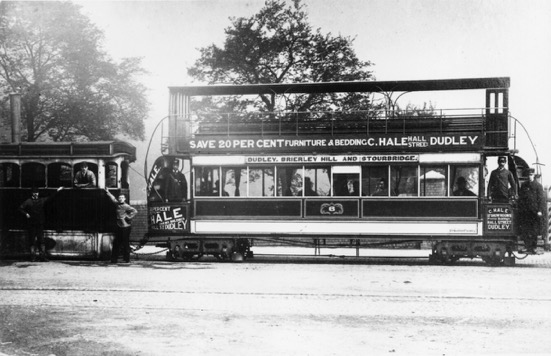
Kitson Steam Tram No 5 and Trailer No 8 (a Midland Railway Carriage and Wagon Works product) at Dudley Station terminus — photo undated, but probably taken in the mid-to-late 1880s. There appear to be two crews present, suggesting that another tram was nearby. Photo courtesy of the Tramways and Light Railway Society, with thanks to David Voice.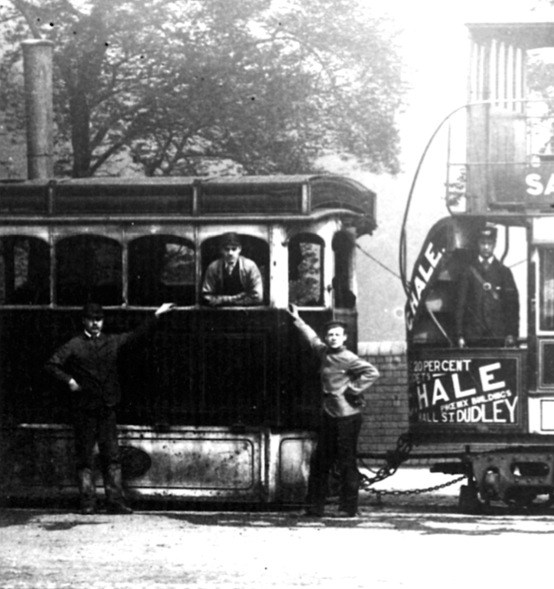
An enlargement of the photograph above, showing the engine men (plus extra man), in railway footplate attire, as well as one of the conductors.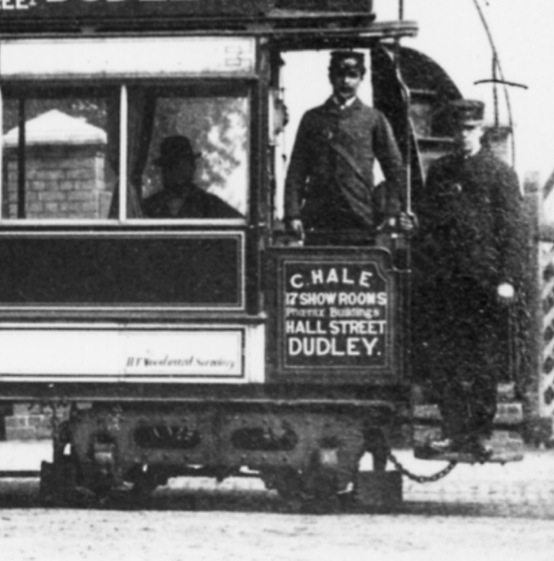
Another blow-up of Trailer No 8 above, showing two conductors with their kepi-style caps, cap badges and uniform jackets.
A group of D&SSTCo steam-tram fitters and drivers, assembled at the depot in Tipton Road, Dudley in 1895. Author's Collection.
An enlargement of the above photograph showing three mean who may well be drivers; all are wearing soft-topped caps.
Motormen and conductors
A rather battered looking DS&DETCo Tramcar No 18 stands with its crew at Scotts Green Junction — photo purportedly taken in 1898, but definitely taken no later than 1902, when this car was rebuilt as a double-deck vehicle. Both men are wearing kepi-style caps, which unusually for a BETCo-owned system, do not carry the standard BETCo 'Magnet & Wheel' cap badge. Photo courtesy of the National Tramway Museum. 
An enlargement of the above photograph showing the motorman. His kepi-style cap seems to be devoid of insignia, though it may possibly be embroidered, and therefore not having caught the light; his metal collar initials appear to be D S & D E T.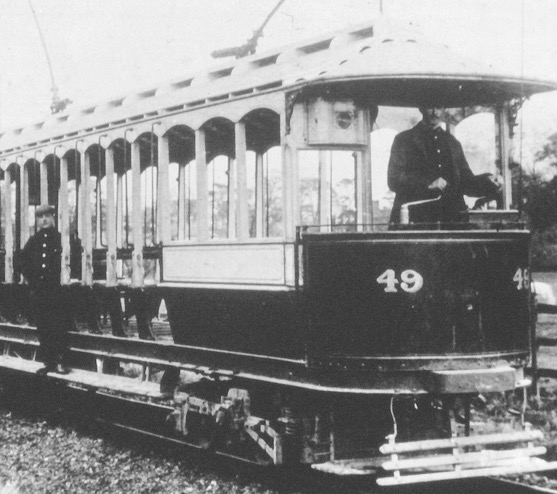
Tramcar No 49 captured at Dunsley Meadow around 1904. Both crewmen are wearing single-breasted jackets with stand-up collars, the latter bearing insignia, though indecipherable in this particular photo. The man on the running board, who may be a conductor, though this is far from clear given that there are no passengers, is wearing a flat cap. Photo courtesy of Dr Paul Collins.
DS&DETCo Tramcar No 2 negotiates Old Hill Cross Junction, heading towards Dudley — photo undated, but possibly taken shortly after the line from Blackheath opened (behind the tram), i.e., in late 1904 or early 1905. Author's Collection.
An enlargement of the above photograph, showing the motorman. He is wearing a double-breasted jacket with high fold-over collars, of the type issued following the creation of the Birmingham and Midland Tramways Joint Committee. His left-hand collar bears an employee number, possibly '25', and the left arm of his jacket a small round badge, possibly a St John's Ambulance badge (or similar). Although there is no sign of a badge on his drooping-peak cap, it is probably obscured by the shadow of the tramcar canopy. 
Another shot taken at Old Hill Cross on the route to Cradley Heath around 1904/5. The tramcar is believed to be No 8, with the crew wearing the recently introduced BMTJC uniforms; the man on the right has a round badge on his left-hand jacket sleeve, possibly a St John's Ambulance badge. Author's Collection.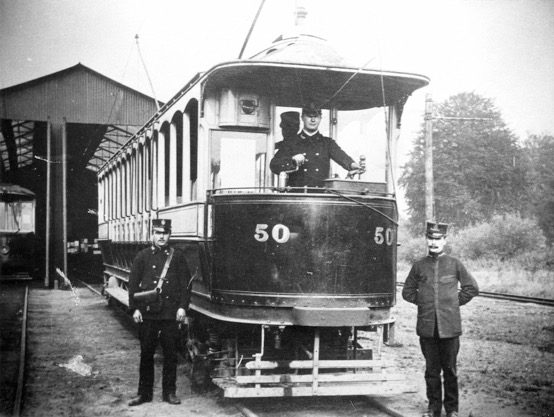
A conductor, a motorman and an inspector (Mr Alf Horton) pose for the cameraman at Kinver depot with Tramcar No 50 — photo undated, but probably taken around 1910/12. Photo courtesy of Dr Paul Collins.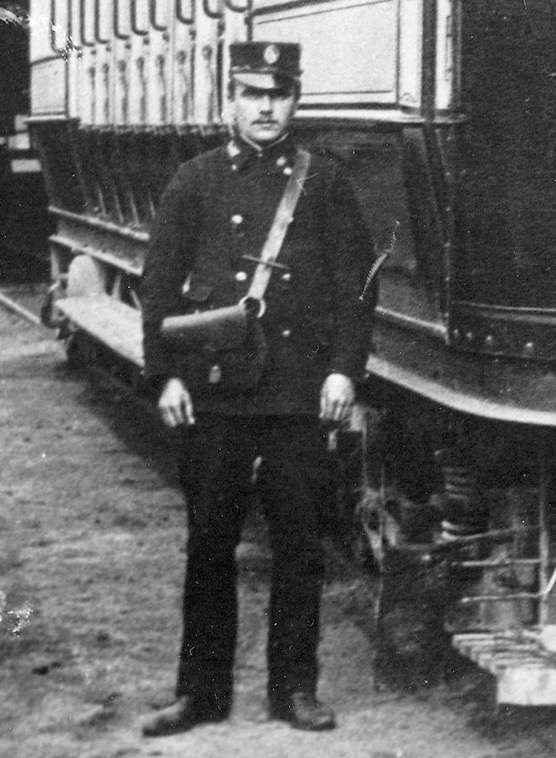
An enlargement of the above photograph showing the conductor. He is wearing a standard B&MT cap badge on his drooping-peak cap.
Birmingham and Midland Tramways Joint Committee cap badge — brass. This was introduced some time after 1904, when ownership of the DS&DETCo (which was also the owner of the Kinver Light Railway) was transferred to Birmingham and Midland Tramways Limited. The badge incorporates the British Electric Traction Company 'Magnet and Wheel' symbol, the latter company controlling the B&MT and all its constituent tramway companies.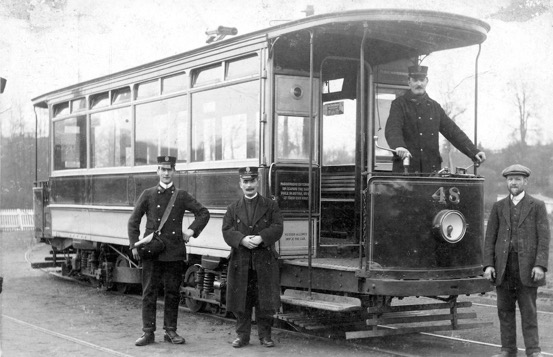
Another photograph taken at Kinver depot, this time of Tramcar No 48, along with a conductor, a motorman and Inspector Alf Horton. The photo is undated, but was definitely taken no earlier than 1912, when No 48 was fitted with the central compartment seen here, and probably prior to the Great War. Photo courtesy of Dr Paul Collins.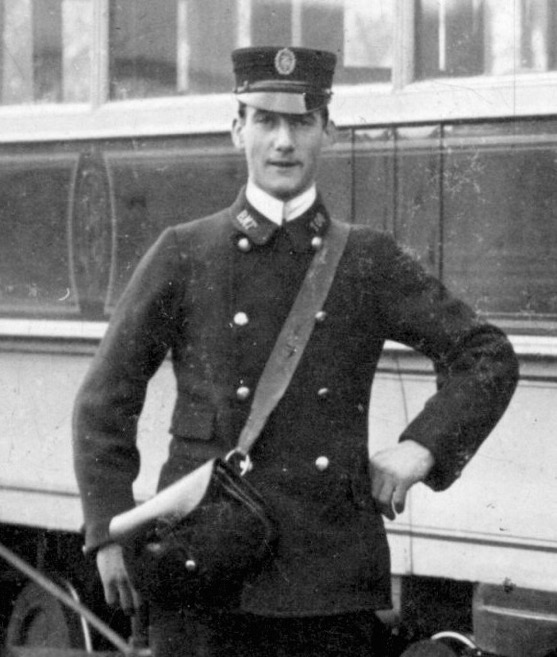
An enlargement of the above photograph showing the motorman. He is possibly Employee No 104 or 164, and the initials on his right-hand collar — 'B M T' — are fairly easy to make out.
Probable B&MTJC early rope-effect collar initials and collar number; this type were eventually superseded by plain brass letters/numbers. Author's Collection.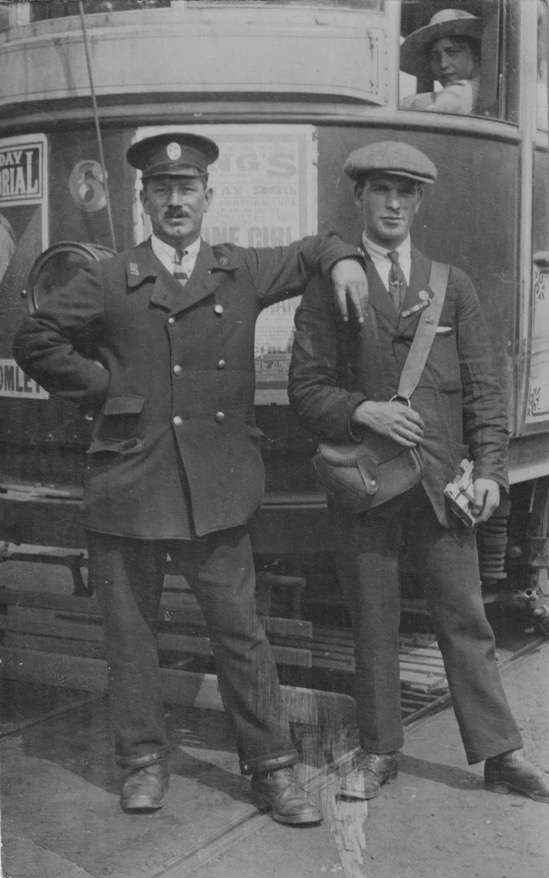
A KLR motorman, known as 'Happy Jack', and his conductor, pose with DS&DETCo Tramcar No 6 — photo undated, but certainly taken during the 1920s, possibly at the Ridge Top. The conductor is wearing informal attire, possibly indicating that he was a seasonal or temporary employee. Author's Collection.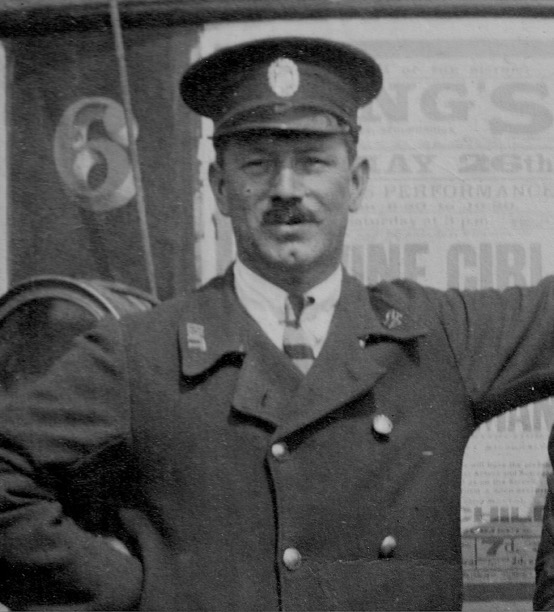
An enlargement of the above photograph showing the motorman. He is wearing the standard B&MTJC uniform, with individual system initials ('B M T') on his right-hand jacket collar, and the standard B&MT badge on his cap.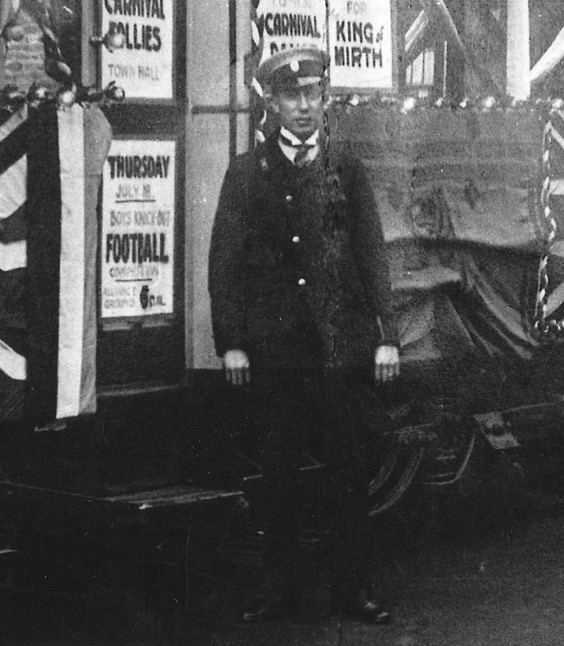
A DS&DETCo conductor stands before a decorated front-exit tramcar outside the Turks Head in Brierley, during Brierley Hill Hospital Carnival Week — photo undated, but almost certainly taken in 1929, one of only three candidate years when the 18th July fell on a Thursday (see football poster). Author's Collection.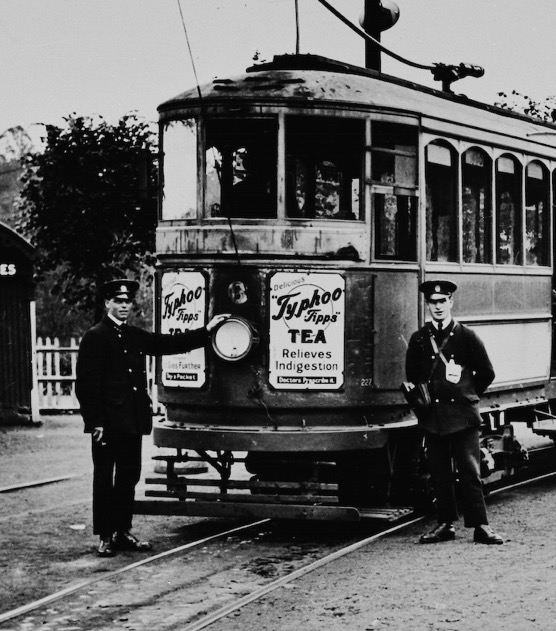
The crew of a rather tatty Tramcar No 6 pose for the cameraman at Kinver Station — photo undated, but probably taken in the late 1920s. Photo courtesy of the National Tramway Museum.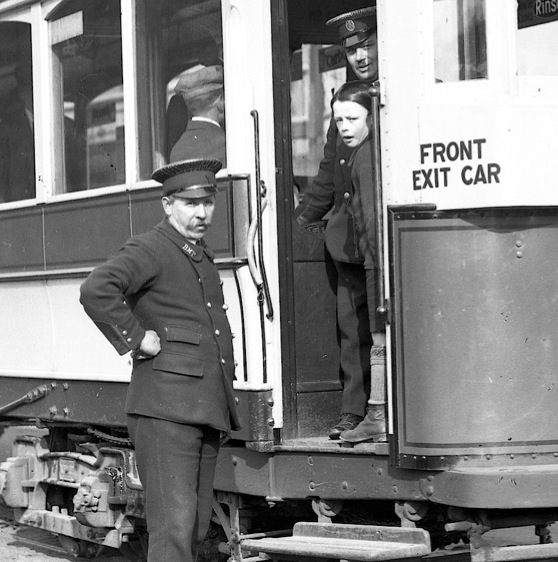
The crew of DS&DET No 57 pose for the camera at the Fish Inn terminus of the Kinver Light Railway on the 25th May 1929. It is unclear why the man on the left is not wearing a cap badge. Photo by Dr H Nicol, courtesy of the National Tramway Museum.
Senior staff
An enlargement of the 1884 photograph above showing two men (extreme left and extreme right) who are in all probability inspectors. Although they are clearly wearing uniforms, there is no sign of insignia, on either the jackets, coats or caps.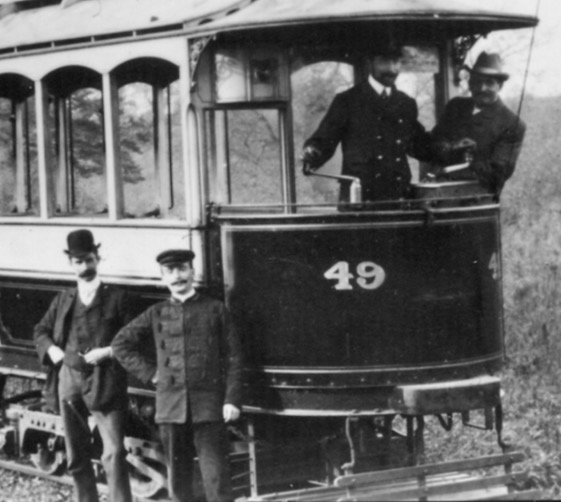
Tramcar No 49 pictured in The Hyde (on the KLR) with company officials and Inspector Alf Horton — photo undated, but probably taken in 1902 or 1903, i.e., before the incorporation of the DS&DETCo into the B&MTL. Inspector Horton is wearing an elaborate 'bandmaster-style' jacket and soft-topped cap. Photo courtesy of the Tramways and Light Railway Society, with thanks to David Voice.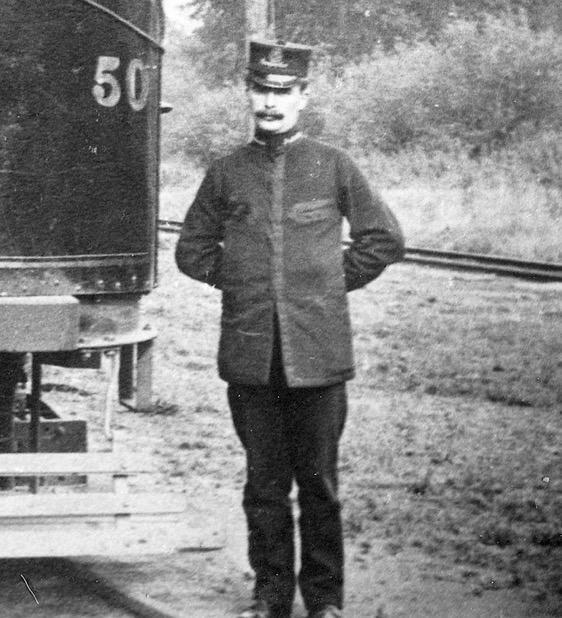
An enlargement of the Kinver depot photograph shown above, taken around 1910, showing Inspector Alf Horton. He is now wearing a more typical tramway inspector uniform, along with a drooping-peak cap with pom pom, bearing an embroidered grade badge and the standard B&MTJC cap badge. Photo courtesy of Dr Paul Collins.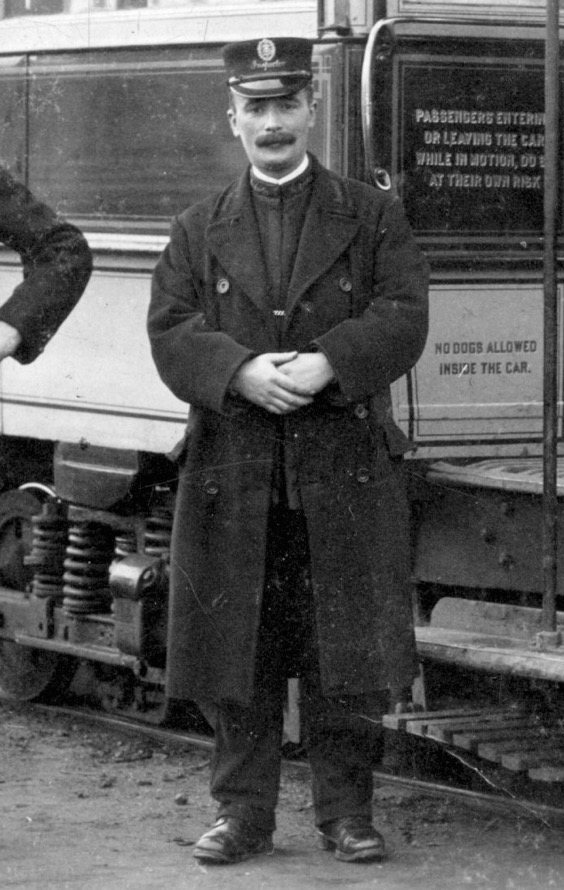
Inspector Alf Horton again, from the slightly later photograph of Tramcar No 48 above (taken after 1912), this time in a double-breasted overcoat. Photo courtesy of Dr Paul Collins.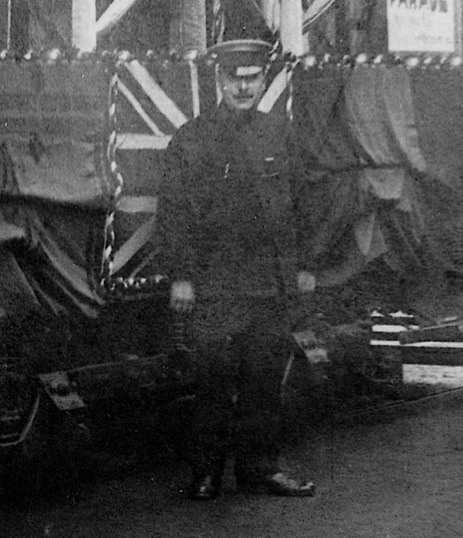
A DS&DETCo inspector stands before a decorated front-exit tramcar during Brierley Hill Hospital Carnival Week (see photo above) — photo undated, but almost certainly taken in 1929. The subject is wearing a tensioned-crown peaked cap, though the cap badges cannot unfortunately be made out. Author's Collection.
Female staff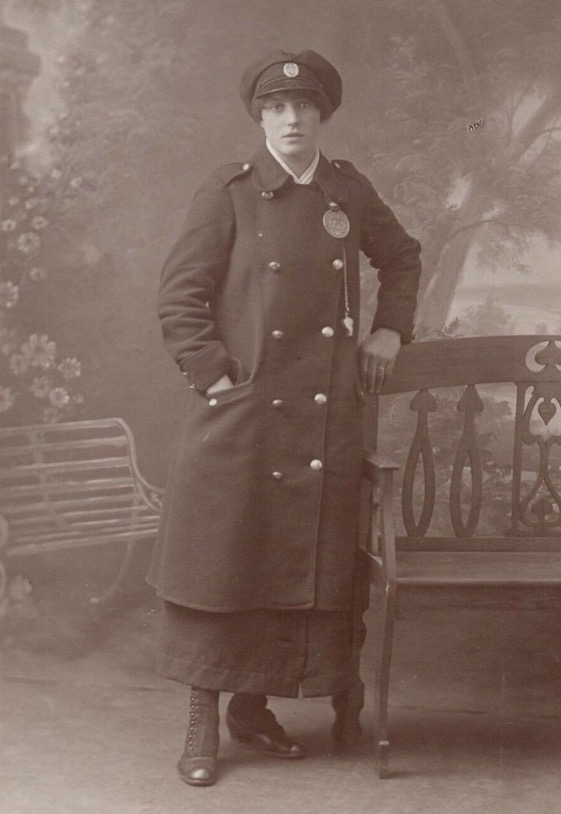
A B&MTJC Great War conductress. She is wearing a lancer-style greatcoat devoid of badges, and a baggy motor cap bearing the standard B&MTJC cap badge. As she is wearing a Birmingham licence, she would have worked for one the tramways that ran services into Birmingham (either the B&MTL or the SST[L]Co). Photo courtesy of Dr Paul Collins.